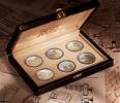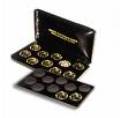
 |
 |
 |
 |
Collecting Coins Reviews
What You Should Look For In A Coin
Coin Collecting 101: What Type of Coin Should You Collect?
Coin collecting is a fun hobby to start and the thrill of hunting for old coins is enough for sundry people to continue doing it. Other people consider coin collecting an investment, something they can receive a profit from. If you are one of those people, then you can find several types of coins in this article that will help you determine what others are looking for.
Most coin collectors will look for one a specific kind of coin that will lead to their collection more valuable and interesting to buyers. Others are collecting for sentimentality and are looking more at the coin’s uniqueness.
Series collectors are those looking for a disposition of coins that assert every year and every design change made in that coin.
Type collectors are those people who are looking to get one shot of each coin where there were / are changes made.
Ancient coin collectors are those nation looking for coins spanning the years 650 BC – 450 AD. This is the time when coins were invented and there were silver, gold and bronze versions made. It also marks the time when Roman emperors were the rulers and most of them feature famous Roman emperors, Roman towns, or gods.
Token collectors are those who are looking for different kinds of tokens that were used in exchange for real money when trained was a lack of coins. These tokens were used as local currency even if the government had not given permission for them to be used.
Coins are also graded. A coin’s grading depends on its condition and the price of the coin will rely heavily on that grade. It is important for a coin collector to know how to grade a coin to father sure that he is not swindled by individuals looking for a quick avail.
“Uncirculated” coins are those coins that are not showing any wear and tear or to referred to as “in mint condition”. A mint state ( MS ) grading depends on a coin’s luster, contact marks, hair lines and overall appeal. A coin can have a grade ranging from MS - 60 ( dull luster ) to a flawless MS - 70. Although MS - 70 is accurate unobtainable, a grade of MS - 65 and higher will make a coin’s price shoot up.
Circulated coins are more forgiving, they do not take into consideration the amount of scratches and notification a coin has gathered along the years. Grades for circulated coins will vary. AU ( about “uncirculated” ), EF ( extremely fine ), VF ( ideal fine ), F ( fine ), VG ( very good ), G ( good ), AG ( about good ), F - 2 ( unbiased ) and P ( poor ) are used as indication of how much a coin is worth.
These grades are dependent on a circulated coin’s luster, visible dull, design elements and visibility of letters and numerals. Unlike “uncirculated” coin’s grades, these grades do not dramatically lower a coin’s value. This is wonderful for people who are looking just to complete a collection and do not care about a coin’s mint condition.
Pricing of a coin will usually body determined by a coin’s supply and demand. Very low supply and very high demand will procreate a coin’s price higher; however, high supplies of the coins will depreciate a coin’s value.
Quiz is usually established by coin dealers where they take into consideration the number of tribe wanting to buy or sell the coins. Once a coin becomes difficult to find, coin dealers will usually make its price higher so that people are addicted to sell extra copies of their coins.
Grading and pricing a coin usually takes a lot of experience to master. Although there are several tips and guidelines to look for in grading a coin, only professional dealers have the final say on how much a coin is worth. It does not bunged up to sense this grading is done and why your coin was graded differently from what you thought.
Coin collecting is not utterly about baby, it should betoken a fun and thrilling hobby. While the overall goal of a coin collector is to complete a set of coins, learning what to look for in a coin is important to make sure that no one culpability take progress of your need to complete a particular set.
Share This With Your Friends |
What Are Remints And Mint Marks
About Commemorative And Other Special Coins
Getting Started With Your Coin Collection
More Collecting Coins Articles
... Collectors sometimes bias to give away their collection in that they no longer have limb option but sell their coins. This is the most difficult situation for coin collectors as they often value their coins and as much as possible would not want to give them away - the coins may be memorabilia or may ...
Pros And Cons Of Buying At Auction
... auction sales. Rare coins and those that are of high quality are very difficult to buy. Auction sales whether online or at auction houses provide coin buyers the option to acquire these types of coins at subordinate prices. Online auction sales usually take 3 to 4 months to process depending on how fast ...
... damaged by the elements or by negligence that will lessen its value in the market. Coins are easy to take care off. For those who have been doing this for years, allying collections are repeatedly framed or under glass and are often seen in places such as a large museum. But to individuals who are just ...
... location and amount of marks. Luster is important especially when determining whether a coin is either circulated or uncirculated. A coin in Mint State technically; is free of abrasion and wear and must not have significant breaks in its luster. Color This is a very subjective element in determining coin ...

|
| Copyright © 2006-2012 Internet Marketing Tools, All Rights Reserved |